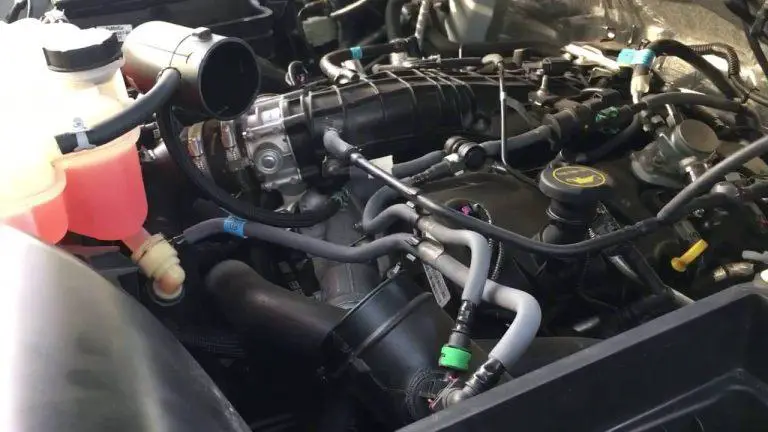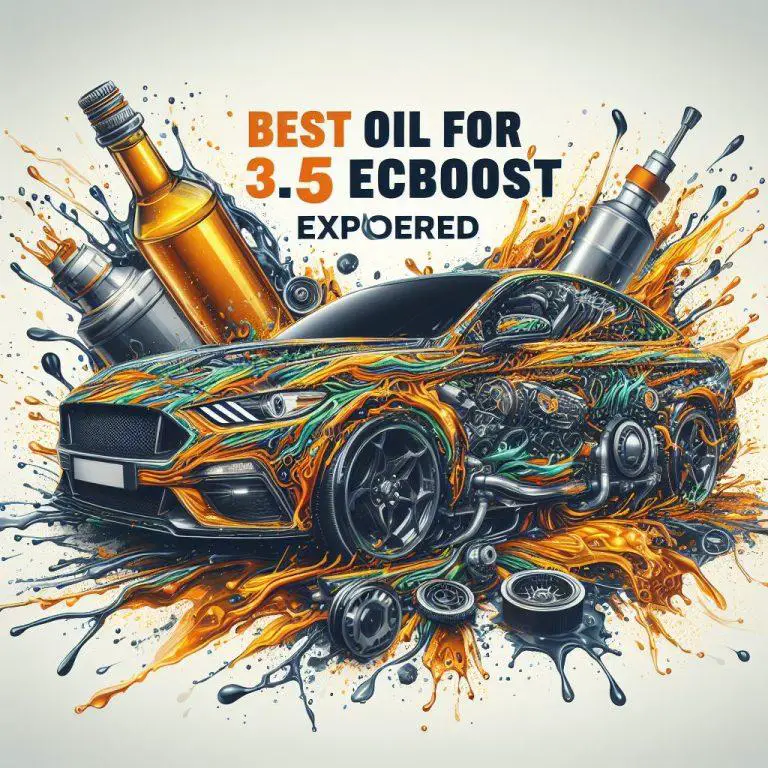Ford Ignition Coil Resistance Specifications
“Your vehicle stalling unexpectedly can be a nightmare, especially when you’re miles away from help.
The culprit? Often, it’s a faulty ignition coil. But understanding the ‘Ford Ignition Coil Resistance Specifications’ can be your first step towards prevention and smooth driving.
This guide is dedicated to demystifying the complexities of ignition coils, ensuring your Ford runs seamlessly, and you stay informed.
Here, we delve into:
- Ford Ignition Coil Resistance Specifications: Unveiling the specifics and what numbers to expect.
- Testing the Ignition Coil: A DIY guide to ascertain your coil’s health.
- The Role and Types of Ignition Coils: Understanding their pivotal function and varieties available.
- Identifying and Replacing Bad Coils: Signs, symptoms, and a step-by-step replacement guide.
- Maintenance Tips: Ensuring longevity and optimal performance of your ignition coils.
Let’s navigate through the intricacies of ignition coils together, ensuring every journey in your Ford remains uninterrupted and smooth!
Ford Ignition Coil Resistance Specifications
Navigating through the realm of Ford Ignition Coil Resistance Specifications not only enhances your knowledge about your vehicle but also empowers you to troubleshoot potential issues.
Unraveling these specifications, we delve into general guidelines and notable examples, ensuring you can both recognize and resolve anomalies in ignition coil readings.
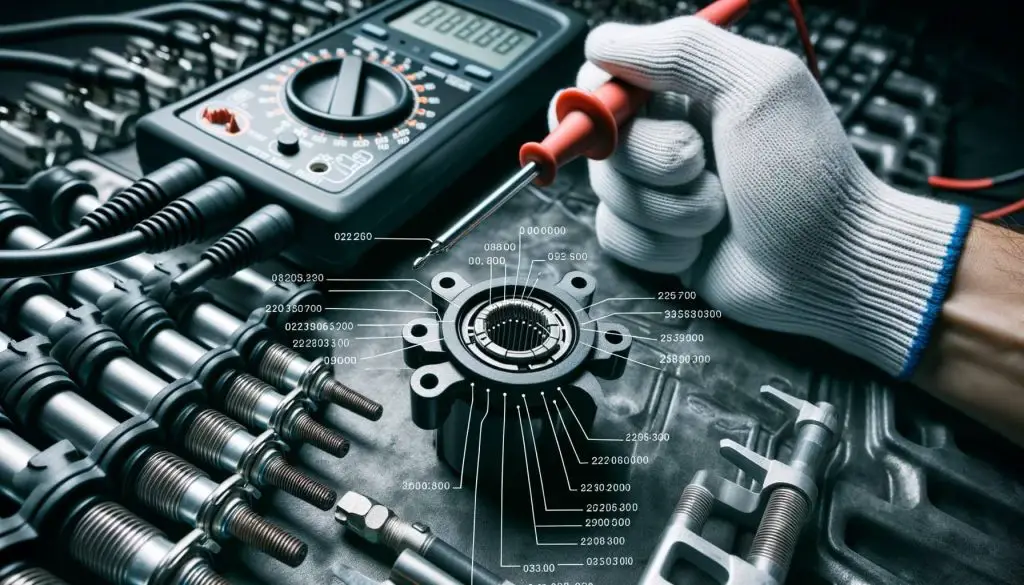
General Guidelines for Resistance
Understanding the resistance values in Ford’s ignition coils is pivotal in ensuring the longevity and optimal functioning of your vehicle.
Generally, a healthy ignition coil will exhibit specific resistance values in its primary and secondary windings.
- Primary Resistance: Typically falls between 0.5 and 1.7 ohms.
- Secondary Resistance: Generally should be between 7,500 and 10,500 ohms.
Specific Examples Across Ford Models
To navigate the specifics, let’s delve into the resistance specifications across various Ford models, providing a snapshot of the diverse specifications encountered in different engine types.
| Year & Model | Primary Resistance | Secondary Resistance |
|---|---|---|
| 1984-’98 TFI ignition coil | 0.200 ohms | 8,800 ohms |
| 2004-’08 F-150 4.6L & 5.4L | 0.55 ohms | 5,500 ohms |
| 2011-’14 F-150 Ecoboost 3.5L | 0.4 ohms | 4,500 ohms |
Each model and engine type comes with its own set of specifications, which are crucial for mechanics and enthusiasts to adhere to during any diagnostic or replacement process.
Consulting Reliable Sources
While the above specifications serve as a general guideline, it’s paramount to consult specific and authoritative sources for accurate details pertaining to your particular vehicle model.
Ensuring that your vehicle’s ignition coils adhere to these specifications not only optimizes performance but also mitigates potential issues, safeguarding your journeys and enhancing your vehicle’s lifespan.
How to Test Ignition Coil Resistance
Ensuring your Ford’s smooth performance involves regular checks and one crucial aspect includes understanding How to Test Ignition Coil Resistance.
Testing the resistance in your vehicle’s ignition coil helps not only in maintaining optimal functionality but also in foreseeing and preventing potential issues.

Importance of Testing for Proper Functioning
Ensuring that the ignition coil operates effectively is pivotal, as this component is instrumental in providing the spark needed for combustion within the engine.
The resistance values, hence, become crucial parameters, dictating the energy flow through the coil.
Note: Regular testing can preemptively identify issues, avoiding unexpected breakdowns and ensuring optimal engine performance.
Step-by-Step Guide to Testing the Ignition Coil Resistance
Navigating through the technicalities of testing ignition coil resistance might seem daunting, but by following a systematic approach, this task becomes straightforward and manageable.
1. Setting up the Multimeter
Utilize a multimeter, ensuring it’s set to the ohms setting, preparing it to measure the resistance across the ignition coil’s terminals.
2. Disconnecting the Ignition Coil
Ensure the engine is off and cool to avoid any injuries. Disconnect the ignition coil from the primary and secondary circuits to isolate it for an accurate reading.
3. Testing Primary Resistance
Attach the multimeter leads to the primary terminals (positive and negative) of the ignition coil. Ensure the reading falls within the specified range of 0.5 and 1.7 ohms.
4. Testing Secondary Resistance
Next, place the multimeter leads on the secondary terminals. The readings should ideally be between 7,500 and 10,500 ohms.
You can also check out the video:
Understanding the Importance of Resistance Readings
Resistance readings serve as a reflection of the ignition coil’s health, providing insights that are crucial for maintaining the optimal functionality of the engine.
Conducting regular checks on the ignition coil resistance not only aligns with proactive vehicle maintenance but also ensures that any potential issues are identified and addressed promptly, safeguarding against unexpected disruptions during your journeys.
Understanding the Role of Ford Ignition Coils
Navigating through the mechanics of your vehicle, it’s pivotal to grasp the role of ignition coils, especially considering their significance in your engine’s operation.
Understanding the Role of Ford Ignition Coils provides insight into the seamless orchestration happening under the hood every time you turn the key, ensuring every drive is smooth and efficient.

Ignition Coils in Sparking the Spark Plugs
Ignition coils play a crucial role in the vehicle’s ignition system, acting as a high-voltage transformer.
It converts the vehicle’s 12-volt electrical charge into the thousands of volts necessary to create an electric spark in the spark plugs, which ignites the fuel.
- Primary Windings: When the ignition is turned on, low-voltage current flows through the primary windings, creating a magnetic field.
- Secondary Windings: When the current is interrupted, the magnetic field collapses, inducing a high-voltage current in the coil’s secondary windings.
- Spark Plug Ignition: This high-voltage current is directed through the coil wire to the distributor, which routes it to the appropriate spark plug for ignition.
Importance in the Combustion Process of the Engine
The ignition coils are pivotal in driving the engine’s combustion process, which is crucial for the vehicle to run. The high-voltage spark generated by the coil ignites the air-fuel mixture in the engine cylinders.
This ignition creates a small explosion, driving the piston down and turning the crankshaft, which propels the vehicle.
- Combustion Stability: Ensuring the spark is reliably and consistently generated is crucial for stable combustion and, therefore, smooth engine operation.
- Engine Efficiency: Accurate timing and intensity of the spark directly impact engine efficiency and fuel consumption.
- Vehicle Performance: The health and functionality of the ignition coil directly correlate with the vehicle’s performance and reliability on the road.
Understanding the intricate role and operation of Ford ignition coils allows for mindful maintenance, ensuring each component contributes towards a smooth, efficient, and reliable driving experience.
Types and Functions of Ford Ignition Coils
Embarking on the journey to comprehend the different Types and Functions of Ford Ignition Coils, we delve into the specifics of various coil types, their functionalities, and how they intricately contribute to your vehicle’s performance.
Ignition coils, with their pivotal role in ensuring smooth engine operations, come in varied types, each with its unique features and applicability’s.

Different Types of Ignition Coils
Delving into the realm of ignition coils, it’s pertinent to understand the varied types available, each with its own unique mechanism and application within the ignition system.
Distributorless Ignition (DIS) Coil
The DIS coil, often used in older Ford vehicles, operates by firing all the spark plugs in the engine simultaneously, without the need for a distributor.
Coil-on-plug (COP) Coil
COP coils are a modern iteration, wherein each spark plug in the engine possesses its individual coil, enhancing efficiency and reliability.
Waste Spark Coil
This coil type fires two spark plugs simultaneously – one during the power stroke and the other during the exhaust stroke, offering a cost-effective yet less efficient alternative.
Note: Each coil type is designed to cater to different engine configurations and requirements, impacting the vehicle’s overall performance and maintenance needs.
The function of Ford Ignition Coils
Navigating through the technicalities of ignition coils reveals a fascinating process wherein a low-voltage current is transformed into the high-voltage spark essential for engine ignition.
Explanation of Primary and Secondary Windings
- Primary Windings: Utilize the battery’s voltage to create a magnetic field.
- Secondary Windings: Produce the high-voltage spark essential for ignition by converting the magnetic field’s collapse into an electrical current.
Process of Creating a High Voltage Spark
The high-voltage spark, pivotal for igniting the fuel within the engine, is generated through a meticulous process involving the charging and collapsing of a magnetic field within the coil, orchestrated precisely to synchronize with the engine’s functioning.
Pros and Cons of Different Ford Ignition Coil Types
Understanding the advantages and disadvantages of each ignition coil type is pivotal in making informed decisions regarding your vehicle’s maintenance and repair.
| Ignition Coil Type | Pros | Cons |
|---|---|---|
| DIS Coil | Simplicity and Cost-effective | Less Efficient and Reliable |
| COP Coil | High Efficiency and Reliable | More Expensive to Replace |
| Waste Spark Coil | Cost-Effective Replacement | Least Efficient |
Guidance on Choosing the Best Ignition Coil Type
The best Ford ignition coil type for you will depend on your vehicle and your budget. If you are looking for the most efficient and reliable option, then COP coils are the best choice.
If you are on a budget, then DIS or waste spark coils may be a better option.
It is important to note that Ford ignition coils are a critical part of the ignition system and should be replaced regularly.
If you are experiencing any problems with your ignition system, such as misfires or hard starting, it is a good idea to have your ignition coils tested by a qualified mechanic.
Understanding the nuances of the different types and functionalities of Ford Ignition Coils enables you to make informed decisions, ensuring your vehicle is equipped with the most suitable components, enhancing its performance and longevity on the road.
Identifying a Bad Ford Ignition Coil
The ignition coil, a pivotal component in your vehicle’s ignition system, can sometimes falter, leading to several issues that could hamper your driving experience.
Identifying a Bad Ford Ignition Coil is paramount in ensuring optimal vehicle performance, and recognizing the symptoms early can circumvent potential future complications.
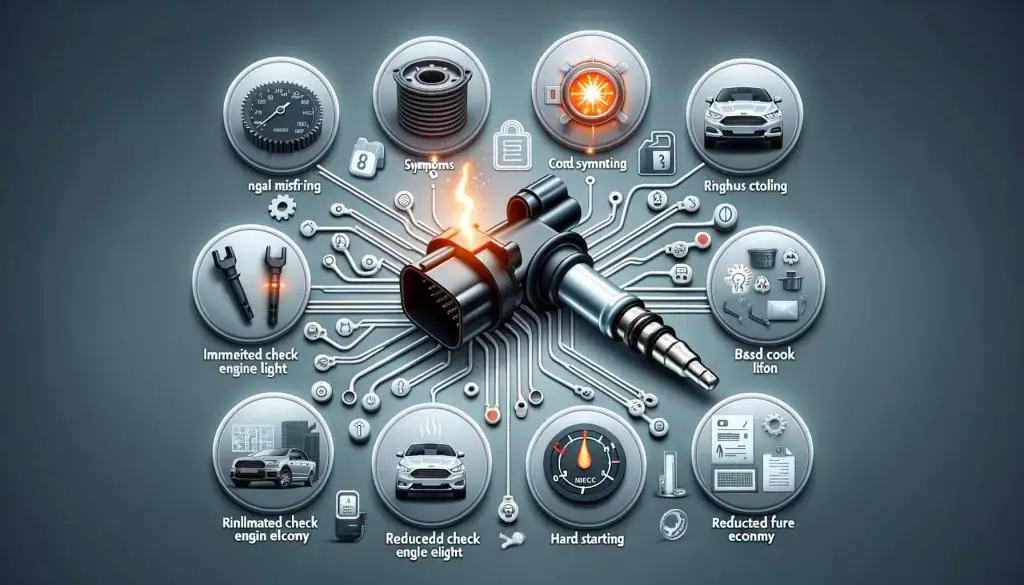
Symptoms Indicating a Faulty Ignition Coil
A faltering ignition coil manifests itself through various symptoms, signaling the need for a meticulous examination and possible replacement.
Engine Misfiring
Experiencing intermittent sputters or inconsistent power while driving can indicate a misfiring engine, often a sign of a malfunctioning ignition coil.
Check Engine Light
While it can illuminate for various reasons, a lit Check Engine Light can denote issues with the ignition coil and should prompt immediate attention.
Reduced Fuel Economy
Inefficient or incomplete combustion due to a failing ignition coil can lead to noticeably reduced fuel economy.
Hard Starting
Challenges in starting the engine, particularly if it’s hard or inconsistent, might indicate a weakened or faulty coil.
Using a Multimeter for Resistance Checks
Conducting a resistance check using a multimeter can offer insights into the health of your ignition coil.
- Primary Resistance: Place the multimeter leads on the primary terminals and ensure readings are within the vehicle-specific optimal range.
- Secondary Resistance: Check resistance across the secondary terminals, again comparing readings against the recommended specifications.
Consulting a Qualified Mechanic for Accurate Diagnosis
While basic checks and understanding symptoms are crucial, consulting a qualified mechanic ensures accurate diagnosis and appropriate interventions.
Ensuring vigilance in recognizing these symptoms and understanding the mechanisms behind ignition coil functionality empowers you to maintain your vehicle effectively, safeguarding against unexpected issues and ensuring smooth, uninterrupted drives.
How to Replace a Ford Ignition Coil
The ignition coil, serving as the heart of your vehicle’s spark generation, can occasionally wear out or malfunction.
Understanding How to Replace a Ford Ignition Coil equips you with the knowledge to ensure that the engine ignition process remains optimal, thus safeguarding against interruptions in your journeys.
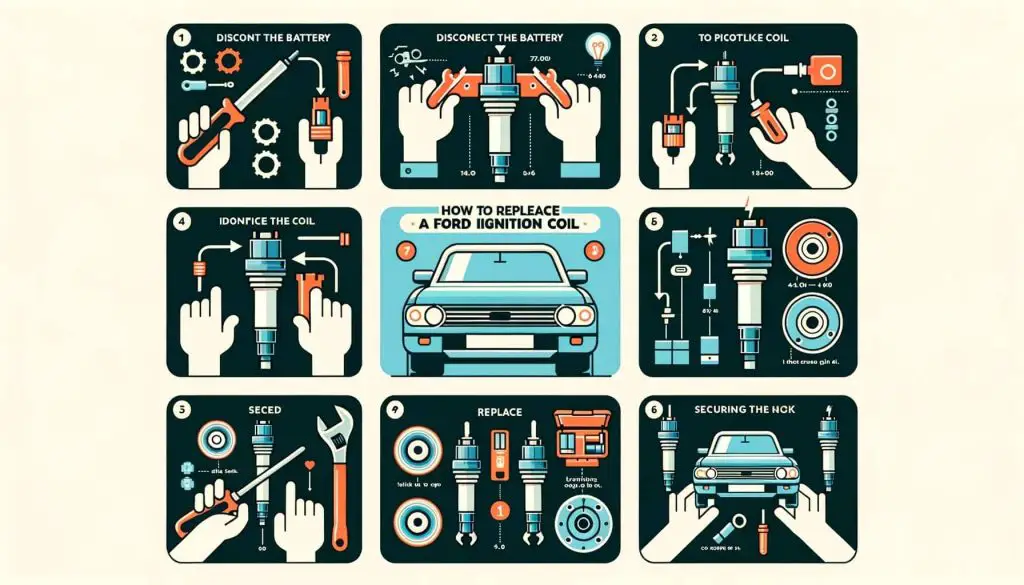
Necessary Tools and Materials
Embarking on the replacement process necessitates having the right tools and materials at hand, ensuring efficiency and safety throughout the procedure.
| Tools/Materials | Purpose |
|---|---|
| Socket Wrench | Loosening and tightening bolts |
| Ratchet | Providing leverage for the wrench |
| Extension Bar | Accessing deep or recessed areas |
| 7mm Socket | Specific for ignition coil bolts |
| 10mm Socket | Used for battery terminal connections |
| Dielectric Grease | Ensuring moisture protection |
| New Ignition Coil | Replacement for the faulty coil |
Step-by-Step Guide to Replace a Ford Ignition Coil
A structured approach to replacing the ignition coil ensures accuracy and safety.
1. Preparing the Engine and Workspace
Ensure the engine is turned off and has cooled down. Disconnect the negative battery cable to prevent any inadvertent electrical connections.
2. Locating and Disconnecting the Faulty Coil
Identify the faulty ignition coil, often situated atop the engine. Carefully disconnect the electrical connector from the ignition coil to isolate it.
3. Replacing and Securing the New Coil
Remove the faulty coil by loosening its securing bolt using the 7mm socket. Once removed, apply a thin layer of dielectric grease to the new coil’s boot for added protection. Position the new coil in place and secure it using the 7mm bolt.
4. Final Checks and Starting the Engine
Reconnect the electrical connector to the new ignition coil. Reconnect the negative battery terminal and start the engine, ensuring smooth operation and listening for any irregularities.
Additional Tips for a Successful Replacement
- Always ensure that the new coil is compatible with your Ford model.
- Ensure the electrical connector is fully seated onto the ignition coil for optimal connection.
- If replacing multiple coils, maintain the order of removal to ensure proper reinstallation.
Safety Precautions to Consider
Prioritizing safety ensures not only a successful replacement but also avoids potential hazards during the process.
Equipped with this comprehensive guide, replacing a Ford ignition coil becomes a manageable task, ensuring that your vehicle continues to operate at its peak performance, providing reliable and efficient journeys.
Ford Ignition Coil Maintenance Tips
Preserving the vitality of your vehicle’s ignition system pivots significantly on the health of the ignition coil.
In this guide on Ford Ignition Coil Maintenance Tips, we navigate through the avenues of maintaining this vital component, ensuring that its functionality and longevity are optimized, thereby safeguarding your vehicle’s performance and reliability.
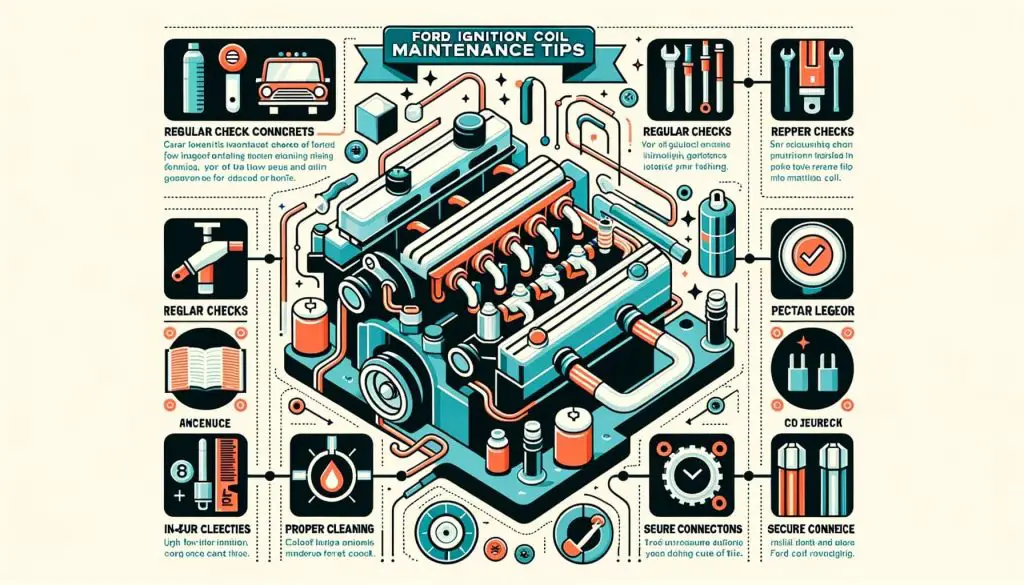
Regular Inspection and Signs to Watch Out For
Conducting regular checks and being aware of certain indicators can provide early warnings before ignition coil issues become critical.
Physical Inspection
| Aspect | What to Check | Potential Issues |
|---|---|---|
| Visual Inspection | – Surface of the coil | – Cracks, burns, or damage |
| – Wiring and connections | – Frayed wires, loose connections | |
| Connection Points | – Security of connections | – Loose or corroded connections |
| – Presence of dirt or debris | – Impaired connection or function |
Performance Indicators
| Symptom | Possible Cause | Action Required |
|---|---|---|
| Misfiring Engine | – Faulty or failing ignition coil | – Check and replace coil if necessary |
| Hard Starts | – Insufficient spark generation from coil | – Diagnose and consider replacement |
| Unstable Idling | – Inconsistent spark delivery | – Investigate coil and connections |
Importance of Keeping Ignition Coils Clean
A clean ignition coil enhances performance and prevents premature wear.
- Prevent Overheating: Keeping coils free from debris prevents overheating and ensures efficient operation.
- Avoid Misfires: Clean coils ensure a strong and consistent spark, reducing the risk of engine misfires.
Using Dielectric Grease for Longevity
Dielectric grease serves as a protective layer, safeguarding the ignition coil from various potential issues.
- Moisture Protection: The grease prevents moisture, safeguarding against corrosion and ensuring consistent electrical conductivity.
- Secure Connections: It aids in maintaining secure and consistent electrical connections within the ignition system.
Manufacturer’s Recommendations on Replacement Intervals
Adhering to the manufacturer’s guidance ensures that the ignition coils are replaced before they exhibit issues.
- Standard Replacement: Manufacturers generally recommend ignition coil replacement every 100,000 miles.
- Model Specific: Always refer to your vehicle’s manual for model-specific guidance.
Tips to Extend the Life of Ignition Coils
Ensuring the longevity of your ignition coils involves adhering to certain best practices and preventive measures.
- Avoid Moisture: Prevent driving through deep water to shield the coil from moisture.
- Use Compatible Spark Plugs: Ensure spark plugs are of recommended specifications to prevent overload.
- Preventive Replacement: Consider replacing coils during major services to prevent future issues.
Navigating through these maintenance tips, you’re now equipped to ensure your Ford ignition coil remains in peak condition, fostering seamless drives and safeguarding against unexpected breakdowns.
Does the Number of O2 Sensors Impact Ford Ignition Coil Resistance?
The number of oxygen sensors in ford f150 can indeed impact the ignition coil resistance. Each oxygen sensor provides data to the engine control module, which then adjusts the ignition coil’s resistance accordingly. With more sensors, the engine can achieve a better air-fuel mixture, optimizing ignition coil performance and overall engine efficiency.
FAQs
What is an ignition coil and what does it do?
An ignition coil is a component of a vehicle’s ignition system that transforms the low voltage of the battery into the high voltage needed to ignite the fuel and air mixture in the engine’s cylinders.
What causes ignition coil failure?
Ignition coil failure can be caused by several factors, including overheating, excessive voltage, and wiring problems. Overloading, lack of proper cooling, and high temperatures can also result in ignition coil failure.
Why is regular maintenance and upkeep important for Ford ignition coils?
Regular maintenance and upkeep are crucial for the longevity and performance of Ford ignition coils. Ignition coils that receive proper maintenance and upkeep are less likely to fail and result in costly repairs. Regular maintenance and upkeep can also help identify potential issues before they lead to ignition coil failure.
Which Spark Plugs Are Compatible with Ford Ignition Coil Resistance Specifications?
When seeking spark plugs compatible with Ford ignition coil resistance specifications, it is crucial to consider ford 46 spark plug recommendations. These recommendations ensure optimal performance and longevity of your Ford vehicle’s ignition system. Choosing the right spark plugs adhering to Ford’s guidelines will help maintain a smooth and efficient engine operation.
Conclusion
Keeping your Ford running smoothly is all about paying attention to the little things, especially when it comes to the ignition coil.
By keeping an eye on Ford Ignition Coil Resistance Specifications and knowing when something’s off, you help your car keep its spark and stay strong on the road.
It’s not just about fixing what’s broken, but making sure things work well for every drive. So, let’s make every trip a smooth one, keeping your Ford happy, one spark at a time!






